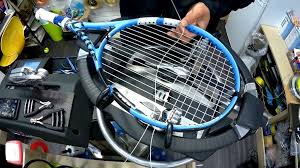When it comes to the game of tennis, precision, power, and control are essential factors that determine a player's success on the court. While aspects like technique, footwork, and strategy are commonly discussed, there's one element that often goes unnoticed but has a significant impact on a player's performance: string tension. The tension at which tennis racket strings are strung can drastically influence a player's game, affecting everything from power and spin to control and feel. In this blog post, we'll delve into the world of string tension and its profound effects on the sport of tennis.
Understanding String Tension:
String tension refers to the amount of force applied to the tennis racket strings when they are strung onto the frame. This tension is typically measured in pounds or kilograms. The tension level can vary widely, with most rackets having a recommended tension range provided by the manufacturer. Generally, higher tension means the strings are strung tighter, while lower tension means they are strung looser.
The Power and Control Balance:
String tension plays a pivotal role in finding the right balance between power and control in a player's game. Higher string tension results in less deformation of the strings upon ball impact, leading to a more "dead" or "solid" feel. This can translate to increased control over shots, as the ball spends less time on the strings, resulting in a crisper response. On the other hand, lower string tension allows for more string deformation, which can generate greater trampoline-like effect upon impact, resulting in more power. However, this may come at the cost of reduced control.
Spin Generation:
String tension also significantly influences a player's ability to generate spin on the ball. With higher string tension, the strings are less likely to move upon ball contact, which can make it slightly more challenging to generate spin. Lower string tension allows the strings to "grab" the ball more effectively, enabling players to create greater topspin or slice, making the ball dip or curve more dramatically.
Comfort and Feel:
String tension can impact a player's comfort level and overall feel while playing. Players who prefer a softer, more comfortable feel often opt for lower string tension, as it provides a bit more give upon ball impact. Higher string tension, while offering more control, can feel stiffer and transmit more vibrations to the player's arm, potentially leading to discomfort or even injury over time.
Adjusting String Tension to Playing Style:
Choosing the right string tension is not a one-size-fits-all decision. Players need to consider their playing style, strengths, and weaknesses. Aggressive baseline players who rely on power might opt for a lower tension to maximize power and spin. On the other hand, players who prioritize control and precision, such as those who play a net-oriented game, might lean towards higher string tension.
Experimentation and Customization:
String tension is not a static choice; players often experiment to find the tension that suits them best. Even minor changes in tension can lead to noticeable differences in play. Professionals and serious amateurs often work with stringers to fine-tune their racket's tension to adapt to different court surfaces, weather conditions, and opponent styles.
String tension might seem like a subtle aspect of tennis equipment, but its effects on a player's game are anything but subtle. The interplay between power, control, spin, comfort, and feel make string tension a crucial consideration for players of all levels. Understanding how string tension affects your style of play can lead to more effective shot-making, improved consistency, and an enhanced overall experience on the tennis court. So, the next time you're considering restringing your racket, remember that those seemingly insignificant numbers on the racket frame can have a profound impact on your performance.

